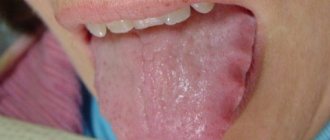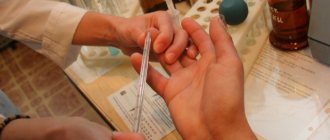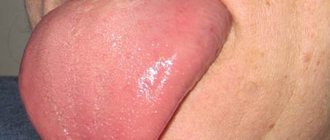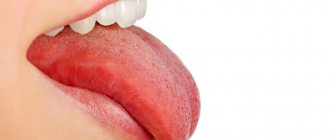Causes of inflammation of the papillae on the tongue
If you have an inflammatory process in your mouth, contact your dentist immediately. Family dentistry in St. Petersburg is a clinic where every patient will be provided with assistance. The doctor will determine the causes of the disease and prescribe treatment. Problems may arise:
- When the patient’s diet includes excessive amounts of sour, sweet, spicy foods;
- If chronic stress develops in the body;
- When the patient received a tongue injury, burn, cuts, punctures;
- If the organ is affected by an allergic reaction;
- For some diseases of internal organs;
The surface of the muscular organ changes significantly under aggressive influence. The provoking factor is xerostomia, disease of the salivary glands, Sjogren's syndrome, diabetes mellitus. With glossitis, the sensitivity of the papillae increases. During the examination, the doctor must exclude HPV, leukoplakia, aphthous stomatitis, syphilis, and oral fibroma. Children are examined for scarlet fever.
Sometimes the disease can be triggered by acid reflux, gastritis, throat infections, systemic inflammation of the gingival tissues when the pathogenic microorganism develops rapidly. Taking some medications can cause pain. High concentrations of alkali or acid have a negative effect on the condition of the muscular organ. Injuries on the tongue can occur from a hard brush, dentures, or tartar.
Healthy tongue
People who do not suffer from severe acute or chronic diseases have a smooth, pink tongue with one even fold running down the middle. At the same time, the organ is very mobile and soft. During a conversation, it does not cause any discomfort or pain to the person. In healthy people, the papillae are clearly visible. At different times of the year, a small amount of white plaque may be visible on the mucous membrane, which may be slightly larger in the summer. In winter, plaque can acquire a yellowish tint. This is normal and does not indicate the development of the disease.
A red tongue in a person, which is slightly enlarged, indicates a metabolic disorder in the body.
Important! Sometimes a little plaque can indicate the progression of a minor oral disease. For example, it could be candidiasis, caries or gingivitis. A denser, bright plaque usually indicates the progression of chronic pathologies.
Symptoms
When the papillae on the tongue become inflamed, tissue sensitivity increases significantly and taste changes. Patients complain of unpleasant discomfort in the mouth. The taste spectrum is distorted and becomes unnatural. In addition, a number of other symptoms appear.
- Noticeable tissue swelling.
- Marked increase in size of the papillae.
- Tingling and itching.
- Burning, mild soreness.
If you do not consult a dentist in time, complications may develop: lingual eruptive papillitis. This disease occurs over a long period of time with an increase in body temperature. Most often the disease affects children. An alarming symptom is the appearance on the surface of the vocal organ of bubbles (pustules) filled with a transparent liquid. When the first signs of illness appear, you should immediately visit the dentist. Timely treatment of the disease minimizes complications and speeds up recovery.
Additional diagnostic criteria
The following deviations are identified, which may indicate the development of a number of diseases:
- An increase in muscle structures occurs with pathologies of the digestive system.
- A slight curvature can be caused by all sorts of neurological pathologies, diseases of the spleen or liver.
- Thickening of muscle fibers occurs with inflammation, pathologies of the thyroid gland or mental illness.
- A wide organ may indicate a lack of nutrients in the human body.
- Dehydration causes the tongue to shrink.
- Severe swelling and pronounced redness of the right side of the organ occurs with inflammatory diseases of the liver. The occurrence of ulcers indicates the neglect of the pathology and its chronic form.
- A shiny surface of the mucous membrane may indicate stomach disease.
- Rough, inflamed papillae usually occur with gastritis.
- The formation of gray spots is possible with prolonged smoking.
- The so-called geographic tongue indicates the development of gastrointestinal diseases.
- When white foamy streaks form, they will indicate the development of rheumatism.
- Clear teeth marks on the sides of the organ indicate hidden neuroses and stress.
A wide organ may indicate a lack of nutrients in the human body.
In addition, the following sensations on the tongue will be identified, which may indicate various diseases:
- Pain in different areas usually occurs with digestive pathologies and disorders in the endocrine system. Sometimes pain occurs after mechanical irritation.
- With iron deficiency in the body, a person may experience a burning sensation in the tongue.
- Trembling occurs with neurological pathologies.
- Impaired taste perception occurs with severe disruptions in the endocrine system.
- A bad odor may indicate dental or stomach disease.
Localization
If the papilla on your tongue is inflamed, visit the dentist. Only he will be able to correctly determine the causes of the disease, find out what caused the damage to the mucous membrane of the mouth and the body of the tongue. The area where the disease is localized plays an important role in making the correct diagnosis. Pathology can cover the entire organ, part of it, or the sides. Based on this factor and the clinical picture, we can assume what exactly caused the inflammation.
In all languages
When the mucous layer of an organ is affected over its entire surface, the most common cause is a thermal or chemical burn. One can assume the infectious nature of the pathology. If the damage is severe, there may be no taste at all. Patients complain of severe burning.
On the root
Most often, the papillae on the tongue at the base become inflamed due to the action of allergens. The affected root of the muscular organ causes difficulties such as the perception of bitterness, because the inflammatory process has affected the circumvallate papillae. They are the ones responsible for this function. The patient's salivation increases, and the tissues in the oral cavity swell. This condition can also be caused by problems with the digestive system, too high or low acidity of gastric juice. It is on the back of the speech organ that bacterial or fungal glossitis is localized.
On the tip
The disease can affect the tip. This often occurs due to mechanical injuries or damage. The edge of the tongue is the first to come into contact with excessively hot food or aggressive drinks, which burns this area. Soft tissues often rub against sharp chips of crowns and are subject to accidental biting.
Side
The delicate surface on the sides often suffers from various anomalies. Leaf-shaped, conical, filamentous, mushroom-shaped structures are exposed by the teeth. This leads to an increase in the papillae, their hyperemia due to mechanical damage from fangs and molars. Also provoking factors are painful microorganisms and burns of chemical origin.
Types of tongue cancer
The disease is classified by localization - the location of the tumor on the tongue:
- Cancer of the tongue body accounts for more than 2/3 of all cases of this pathology.
- Cancer of the root of the tongue - 1/5 of all cases.
- Lower surface cancer – all remaining cases (about 10%).
Photo: squamous cell carcinoma of the tongue
Based on the principle of tumor growth, the following clinical forms of the disease are distinguished:
- Exophytic – the tumor grows mainly in the oral cavity. Sometimes this form of the disease is called papillary.
- Endophytic (infiltrative) – growth is directed into the thickness of the organ. Endophytic growth is a characteristic symptom of tongue root cancer. Very often, this form of the disease leads to swelling and difficulty in moving the tongue or to its complete immobility.
Tongue cancer is classified as squamous cell in 95% of cases, and only in 5% is it another histological form: carcinoma or basal cell carcinoma.
Based on the appearance of the tumor, papillary and ulcerative forms are distinguished. Papillary cancer is the most common type of disease.
It looks like a dense growth, somewhat elevated above the mucous membrane and covered with “warts”.
In the ulcerative form of the disease, an ulceration appears on the surface of the tongue on the side or back, surrounded by a ridge. A characteristic property of an ulcer at an early stage is its complete painlessness. As the ulcer grows, pain appears and bleeding is noted. The addition of an inflammatory component masks cancer and complicates diagnosis.
Photo of tongue cancer
Pictured is papillary tongue cancer
The photo shows a tumor on the side of the tongue
The photo shows an ulcerative form of cancer
Pictured is tongue root cancer
Diagnostics
Basic diagnostic methods in dentistry allow a thorough examination to be made in order to make the correct diagnosis. During the initial examination, the dentist determines the size of the pathological zones, appearance, color, and shape of the organ. The doctor finds out whether there is swelling of the tongue, ascertains plaque and its localization, abrasions, punctures, eczema, ulcers. The health of gum tissue and teeth is important.
In order to determine the type of pathogen and the form of the disease, a number of tests are prescribed:
- Histological smear;
- Sensitivity is determined using a special test;
- A general blood test is informative;
Systemic pathologists are also excluded: HIV, syphilis, hepatitis, AIDS. If necessary, the patient is referred for consultation to a gastroenterologist, dermatologist, endocrinologist, otolaryngologist, or immunologist.
Diagnostic criteria
Today, the diagnosis of a patient when pathologies of internal organs are identified is also often confirmed after a doctor examines the person’s tongue. To identify a disease by the tongue, you should not only know what a healthy tongue looks like, but also pay attention to the following criteria:
- Color. Not only the overall color of the organ is taken into account, but also its shade in different areas.
- The presence of plaque, its color and density.
- Size and shape.
- The condition of the mucosal surface (is it smooth, loose, rough, etc.).
- The mobility of the organ and the presence or absence of foreign formations on it (ulcers, papillomas, pimples, etc.). The exact localization of these formations may indicate a specific diseased organ. With proper understanding and identification of the above-described criteria, you can obtain information about the state of the functions and systems of the body.
A healthy tongue has no plaque and is smooth and pink.
Important! Changes in the covering of the tongue are usually observed in diseases that do not have a direct connection with pathologies of the oral cavity. That is why, when plaque or other changes appear, a person is advised to contact not only a dentist, but also a gastroenterologist, hepatologist and endocrinologist.
Treatment
The diagnostic result allows you to prescribe treatment. Therapeutic dentistry has new methods and technologies that will return the patient to health.
- The patient is advised to adjust his diet and reduce spicy and sour foods in his diet. Dishes should not be hot.
- Fillings and dentures that injure the mucous membranes need to be replaced.
- You should have your oral cavity professionally sanitized.
- Remove soft and hard deposits on crowns.
- Cure caries, gum inflammation.
The therapeutic course may include taking antibiotics, anti-inflammatory drugs, and a course of treatment for diseases of internal organs. Regular visits to the dentist are a way to prevent oral problems and complications of existing diseases.
An injured, inflamed muscle organ requires tissue regeneration. For this purpose, drugs containing carotene are prescribed: Aekol, Retinol, Chlorophyllipt, Lugol. Ointment applications are made from Solcoseryl and Cholisal. For pain, anesthetics are used: Trimecaine solution, Anastezin emulsion. Patients are recommended medications to stimulate the body's defenses and vitamins.
If the disease is infectious, a scraping is first done. A pathogenic microorganism is identified in the laboratory. Then therapy is carried out according to the obtained strains. Candidiasis is eliminated with fluconazole. Acyclovir is prescribed against herpes. Metrogil-denta treats protozoal infections.
Causes of the disease
Among the causes of anal inflammation
:
- chemical burns and other damage to the papillae;
- problems with bowel movements;
- low physical activity and sedentary lifestyle;
- too frequent and improper use of enemas;
- haemorrhoids;
- infectious diseases of the rectum and anus.
The following factors can lead to tongue papillitis:
:
- chemical damage to the oral mucosa;
- misuse of medications;
- thermal burns or, conversely, hypothermia;
- gastrointestinal diseases, in which the mucous membrane can be affected by stomach acids;
- mechanical injuries of the tongue and larynx;
- excessive oral hygiene;
- infections in the nasopharynx and oral cavity.
Optic nerve papillitis can be caused by
:
- nerve infarction;
- multiple sclerosis;
- temporal arteritis;
- cancer metastases affecting the nerve;
- meningitis;
- syphilis, etc.
Papillitis localized in various organs of the gastrointestinal tract can provoke
:
- poor nutrition;
- metabolic failures;
- infections affecting the gastrointestinal tract;
- allergy;
- diseases of the endocrine system;
- pathologies of the cardiovascular system.
Inflammation of the papillae on a child's tongue
If the child’s body is weakened and he complains of discomfort in the mouth and pain in the muscle organ, parents should immediately show him to the pediatrician and pediatric dentist. The doctor will determine whether his papillae are red and whether there is an inflammatory process in the mouth. Once the diagnosis is made, therapy is prescribed. As a preventive measure, parents should ensure that the baby regularly brushes his teeth and rinses his mouth thoroughly. Children's immunity is not strong enough, so the body cannot cope with the disease on its own. The situation is complicated by the fact that children are curious; they put most objects in their mouths. To avoid serious complications, take your child to the dentist regularly.
Prevention
Prevention of tongue cancer involves reducing exposure to risk factors and regular dental checkups. In order to minimize the likelihood of developing this disease, it is necessary to give up smoking and alcohol abuse, as well as the use of chewing mixtures. Monitor your oral health carefully. Chronic injury to the tongue should not be allowed; teeth must be treated and dentures adjusted in a timely manner. If long-term (more than 2 weeks) formations are detected, you definitely need to consult a doctor as soon as possible. [1.7]
| More information about treatment at Euroonco: | |
| ENT oncologists | from 5100 rub. |
| Chemotherapy appointment | 6900 rub. |
| Emergency oncology care | from 12100 rub. |
| Palliative care in Moscow | from 44,300 rubles per day |
| Radiologist consultation | 11500 rub. |
Book a consultation 24 hours a day
+7+7+78
Bibliography:
- Clinical recommendations. — Malignant neoplasms of the oral cavity. Ministry of Health of the Russian Federation. — 2022.
- MM. Soloviev. — Practical Oncology • T. 4, No. 1 – 2003, Cancer of the mucous membrane of the oral cavity and tongue (reserves for improving treatment results), 2003
- A.L. Yudin. — Cancer of the tongue and floor of the mouth: modern aspects of diagnosis — Bulletin of Radiology and Radiology No. 5, 2015.
- Clinical protocol for diagnosis and treatment. — Malignant neoplasms of the oral cavity. The Republic of Kazakhstan. — 2015.
- Malignant tumors of the organs of the mucous membrane of the oral cavity and tongue. Educational method. manual./O.P. Chudakov, L.E. Moiseichik, T.B. Lyudchik, L.G. Bykadorova. - Mn.: BSMU, 2007. - 39 p.
- V.A. Soloviev. — Possibilities of ultrasound diagnosis of tumors of the tongue and floor of the mouth. — Oncology. Journal named after P.A. Herzen, 4, 2015. doi: 10.17116/onkolog20154418-21.
- A.R. Gevorkov. – Independent conservative and combined treatment of tongue cancer. – Oncology. Journal named after P.A. Herzen, 4, 2014.
- Rodrigo Arrangoiz. — Oral Tongue Cancer: Literature Review and Current Management. - Сancer Rep Rev, 2022. - Volume 2(3): 1-9. - doi: 10.15761/CRR.1000153.
Color change
The shape, size, outline, color and surface of the tongue are important for diagnosis. Let's start with color.
● Pallor may indicate anemia and poor circulation, as well as intestinal dysfunction.
● A yellowish tint will indicate excess bile in the gallbladder or liver dysfunction.
● Blueness of the middle and especially the lower part of the tongue is associated with cardiac pathology.
● Raspberry color is a consequence of damage to the blood system.
Changes in the color of individual areas of the tongue indicate problems in the organ for which this area is “responsible”. For example, redness of the tip occurs with ailments of the pelvic organs, and if the tongue changes color in the middle part along the edges, the reason probably lies in pulmonary diseases.
● Plaque indicates the presence of toxins in a particular part of the digestive system. The coated back of the tongue indicates slagging in the large intestine, and if the middle of the tongue is “powdered,” it means problems in the stomach or small intestine. A yellowish, gray or brownish coating can identify ailments of the gastrointestinal tract; blue - typhus, dysentery.
Clinical manifestations
The first thing those suffering from glossitis encounter is pain, burning, and severe discomfort in the oral cavity. Over time, the intensity of these manifestations increases, making it difficult to eat food. Taste sensations are dulled and may be completely absent. Some patients have a phenomenon called perverted taste.
The tongue swells, which causes severe discomfort. The patient's speech is impaired, any movements of the tongue bring pain. Hyperthermia and deterioration in general health are possible.
Upon examination, you can reveal an enlargement of the tongue, a change in its color to a brighter one, up to crimson. Ulcers, blisters, spots, erosions, plaque, and lesions with altered epithelial structure may appear on the mucous membrane.
The most dangerous complication of glossitis is phlegmon. A focus of purulent inflammation is formed, which rapidly spreads to the chin and neck. Soft tissues are destroyed. Such patients require emergency medical care.
The tongue is a small muscular organ of the human body. The tongue is located at the bottom (lower wall) of the oral cavity and, with the teeth closed, almost completely fills it, while in contact with the hard palate, gums, and teeth.
Anomalies of the tongue can be either congenital or acquired; they are often the result of certain pathological processes occurring in the body. Currently, malformations of the main speaking organ are quite rare. Many of them are serious problems that often require surgery.
- Genetic diseases . May be inherited or develop as a result of new mutations, diseases such as: Beckwith-Wiedemann syndrome, Down syndrome, Sotos syndrome, hereditary mucopolysaccharidosis
- Exogenous factors . This group of reasons includes exposure of the fetus to ionizing radiation, carcinogens, chemicals, radioactive radiation, and pesticides in food products consumed by a pregnant woman. The development of maxillofacial anomalies is facilitated by bad habits of parents (drinking alcohol, drugs, smoking), and the expectant mother taking medications with teratogenic effects (this is a drug composition that is prohibited during pregnancy).
- Endogenous factors . Include infectious and metabolic diseases of the pregnant woman: trichomoniasis, toxoplasmosis, viral infections, hypovitaminosis and hypervitaminosis A, hypothyroidism, etc. The number of congenital craniofacial dysmorphias increases in proportion to the mother’s age at the time of conception.
A generally accepted classification of tongue defects has not been developed.
Based on the main criteria (size, structure, method of attachment), anomalies can be divided into the following groups:
- Anomalies of size - macroglossia (hypertrophied tongue), microglossia (reduced tongue).
- Anomalies of structure/shape - aplasia and aglossia (absence of tongue), cleft tongue (double. Cleft tongue can be complete or incomplete.
- Anomalies of attachment - ankyloglossia. This anomaly limits the mobility of the tongue in the oral cavity, and, consequently, its functions.
- Combined anomalies – folded (furrowed, scrotal) tongue. Characterized by the presence of folds and grooves on the surface of the organ
Macroglossia - massive tongue. Such a tongue does not fit in the oral cavity and literally falls out of the mouth. The child develops an incorrect bite due to constant pressure on the dentition. Teeth imprints are visible on the lateral surfaces of the tongue. Due to the constantly open mouth, the mucous membrane dries out, which causes discomfort. This is also a big disadvantage for correct sound pronunciation and food intake. A dental surgeon comes to the rescue again; he performs an operation to reduce the muscle mass of the tongue, that is, plastic surgery.
Microglossia is characterized by underdevelopment and reduction in the size of the tongue. Depending on the severity of the defect, a disturbance in sucking occurs, and subsequently in speech. There are cases when the anomaly is asymptomatic. The small tongue is not able to take the desired articulatory position: the amplitude of its movements is too small. In the case of microglosia, a pediatric dental surgeon performs tongue plastic surgery. At what age? Only the doctor can decide this. After the operation there is a rehabilitation period and sessions with a speech therapist.
Aglossia is a rare anomaly in which the tongue is completely absent. With aglossia - the complete absence of an organ - the baby cannot suck, so this rare anomaly requires tube feeding
Ankyloglossia is a congenital anomaly that is discovered shortly after birth. It is characterized by partial or complete shortening of the lingual frenulum. The average length of the frenulum is 1.5 cm. Deviations from the norm (shortened or very short): 1. The frenulum is thin, almost transparent, but prevents the rise of the tongue. 2. The bridle is thin . Its anterior edge is attached close to the tip of the tongue. Because of this, when the tongue is raised upward, the tip bifurcates into a “heart”. 3. The bridle is a dense short cord. It is attached close to the tip of the tongue. The upward movement of the tongue is limited. When you try to stick your tongue out of your mouth, its tip curls up and the back of the tongue “bulges out.” 4. A dense short cord of the frenulum is tightly fused with the muscles of the tongue: attached almost to the tip of the tongue. All movements of the tongue are sharply limited. 5 . It is difficult to understand where the frenulum is and where the tongue is, they are a single whole . It seems that the tongue has fused with the bottom of the oral cavity. With such a language, it’s not only impossible to speak, it’s impossible to eat!
All these deviations from the norm in the structure of the hyoid frenulum will at first complicate the process of feeding the child, and subsequently will prevent the timely appearance of not only the sounds [P] - [P'], but also the whistling sounds [S], [Z], [C]; hissing [Sh], [F], [H], [Sh]; sonors [Y], [L], [L'], back-lingual [K], [G], [X].
Parents for the most part do not like to listen to arguments in favor of surgery on the hyoid frenulum. They rely on exercises that supposedly stretch the frenulum. A similar misconception is noted among speech therapists. We would like to disappoint you: the frenulum does not stretch during speech therapy work, although with the help of special articulation exercises you can significantly increase the mobility of the tongue, due to which the impression is created that something has “stretched” somewhere. In fact, the time for producing sounds is extended, wasting the energy of both the child and the speech therapist.
What else can a child’s tongue “tell” about?
Recently, children with “geographical language” have become increasingly common. The surface of such a tongue is covered with streaks of white, brown and pink colors, with outlines reminiscent of a map of the continents, hence the name. At the same time, the mucous membrane of the tongue is shiny, as if polished, and taste buds are faintly visible on it. This is the state of the tongue to talk about the need to visit an allergist and gastroenterologist . A visit to a speech therapist is also required. As a rule, the sensitivity of such a tongue and mobility are significantly limited, so it is necessary to carry out articulatory gymnastics and the production of certain sounds.
Sometimes the surface of the tongue is dotted with deep grooves “Folded tongue”, like wrinkles. A sort of old tongue. He is painfully dry and inactive, which negatively affects sound pronunciation. A similar feature occurs when there is a disruption in the endocrine system, so do not put off a visit to the endocrinologist.
Attention should also be drawn to the child’s too pale, loose and flaccid tongue. In such a language, muscle tone is reduced (hypotonicity), its movements are slow and unclear, and it is sometimes impossible for him to take the necessary articulatory posture to pronounce a particular sound. Hence the errors in sound pronunciation: “porridge in the mouth.”
If the tongue is too tense, which is why its back is upturned, like a “hump,” and in the protruded position the tongue turns blue, the tip of the tongue deviates to the side, there is hypertonicity. In both the first and second cases, the child should be shown to a pediatric neurologist; perhaps such phenomena are a consequence of birth trauma, encephalopathy or some other diseases.
Conclusion.
Language is a map of internal problems.
The noted anomalies in the structure of the articulatory organs have different effects on sound pronunciation.









